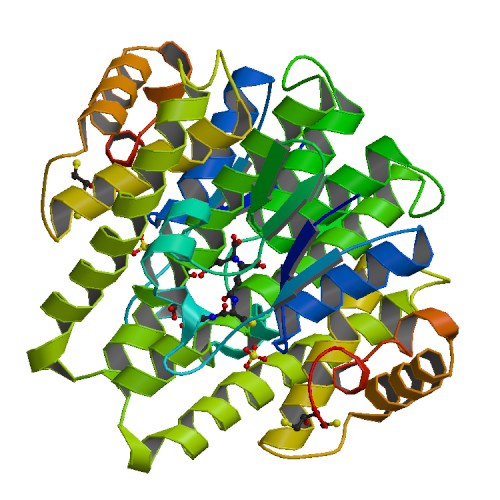GSTZ1
| Glutathione transferase zeta 1 (maleylacetoacetate isomerase) | |||||||||||||
|---|---|---|---|---|---|---|---|---|---|---|---|---|---|
 PDB rendering based on 1fw1. | |||||||||||||
| |||||||||||||
| Identifiers | |||||||||||||
| Symbols | GSTZ1 ; GSTZ1-1; MAAI; MAI; MGC2029 | ||||||||||||
| External IDs | Template:OMIM5 Template:MGI HomoloGene: 7747 | ||||||||||||
| |||||||||||||
| RNA expression pattern | |||||||||||||
 | |||||||||||||
| More reference expression data | |||||||||||||
| Orthologs | |||||||||||||
| Template:GNF Ortholog box | |||||||||||||
| Species | Human | Mouse | |||||||||||
| Entrez | n/a | n/a | |||||||||||
| Ensembl | n/a | n/a | |||||||||||
| UniProt | n/a | n/a | |||||||||||
| RefSeq (mRNA) | n/a | n/a | |||||||||||
| RefSeq (protein) | n/a | n/a | |||||||||||
| Location (UCSC) | n/a | n/a | |||||||||||
| PubMed search | n/a | n/a | |||||||||||
Glutathione transferase zeta 1 (maleylacetoacetate isomerase), also known as GSTZ1, is a human gene.[1]
This gene is a member of the glutathione S-transferase (GSTs) super-family which encodes multifunctional enzymes important in the detoxification of electrophilic molecules, including carcinogens, mutagens, and several therapeutic drugs, by conjugation with glutathione. This enzyme also plays a significant role in the catabolism of phenylalanine and tyrosine. Thus defects in this enzyme may lead to severe metabolic disorders including alkaptonuria, phenylketonuria and tyrosinaemia. Several transcript variants of this gene encode multiple protein isoforms.[1]
References
Further reading
- Ketterer B (2001). "A bird's eye view of the glutathione transferase field". Chem. Biol. Interact. 138 (1): 27–42. PMID 11640913.
- Board PG, Baker RT, Chelvanayagam G, Jermiin LS (1998). "Zeta, a novel class of glutathione transferases in a range of species from plants to humans". Biochem. J. 328 ( Pt 3): 929–35. PMID 9396740.
- Fernández-Cañón JM, Peñalva MA (1998). "Characterization of a fungal maleylacetoacetate isomerase gene and identification of its human homologue". J. Biol. Chem. 273 (1): 329–37. PMID 9417084.
- Tong Z, Board PG, Anders MW (1998). "Glutathione transferase zeta catalyses the oxygenation of the carcinogen dichloroacetic acid to glyoxylic acid". Biochem. J. 331 ( Pt 2): 371–4. PMID 9531472.
- Tong Z, Board PG, Anders MW (1999). "Glutathione transferase zeta-catalyzed biotransformation of dichloroacetic acid and other alpha-haloacids". Chem. Res. Toxicol. 11 (11): 1332–8. doi:10.1021/tx980144f. PMID 9815194.
- Blackburn AC, Woollatt E, Sutherland GR, Board PG (1999). "Characterization and chromosome location of the gene GSTZ1 encoding the human Zeta class glutathione transferase and maleylacetoacetate isomerase". Cytogenet. Cell Genet. 83 (1–2): 109–14. PMID 9925947.
- Fernández-Cañón JM, Hejna J, Reifsteck C; et al. (1999). "Gene structure, chromosomal location, and expression pattern of maleylacetoacetate isomerase". Genomics. 58 (3): 263–9. doi:10.1006/geno.1999.5832. PMID 10373324.
- Blackburn AC, Tzeng HF, Anders MW, Board PG (2000). "Discovery of a functional polymorphism in human glutathione transferase zeta by expressed sequence tag database analysis". Pharmacogenetics. 10 (1): 49–57. PMID 10739172.
- Polekhina G, Board PG, Blackburn AC, Parker MW (2001). "Crystal structure of maleylacetoacetate isomerase/glutathione transferase zeta reveals the molecular basis for its remarkable catalytic promiscuity". Biochemistry. 40 (6): 1567–76. PMID 11327815.
- Blackburn AC, Coggan M, Tzeng HF; et al. (2002). "GSTZ1d: a new allele of glutathione transferase zeta and maleylacetoacetate isomerase". Pharmacogenetics. 11 (8): 671–8. PMID 11692075.
- Strausberg RL, Feingold EA, Grouse LH; et al. (2003). "Generation and initial analysis of more than 15,000 full-length human and mouse cDNA sequences". Proc. Natl. Acad. Sci. U.S.A. 99 (26): 16899–903. doi:10.1073/pnas.242603899. PMID 12477932.
- Heilig R, Eckenberg R, Petit JL; et al. (2003). "The DNA sequence and analysis of human chromosome 14". Nature. 421 (6923): 601–7. doi:10.1038/nature01348. PMID 12508121.
- Ota T, Suzuki Y, Nishikawa T; et al. (2004). "Complete sequencing and characterization of 21,243 full-length human cDNAs". Nat. Genet. 36 (1): 40–5. doi:10.1038/ng1285. PMID 14702039.
- Ricci G, Turella P, De Maria F; et al. (2004). "Binding and kinetic mechanisms of the Zeta class glutathione transferase". J. Biol. Chem. 279 (32): 33336–42. doi:10.1074/jbc.M404631200. PMID 15173170.
- Gerhard DS, Wagner L, Feingold EA; et al. (2004). "The status, quality, and expansion of the NIH full-length cDNA project: the Mammalian Gene Collection (MGC)". Genome Res. 14 (10B): 2121–7. doi:10.1101/gr.2596504. PMID 15489334.
- Hui J, Hung LH, Heiner M; et al. (2005). "Intronic CA-repeat and CA-rich elements: a new class of regulators of mammalian alternative splicing". EMBO J. 24 (11): 1988–98. doi:10.1038/sj.emboj.7600677. PMID 15889141.
- Rual JF, Venkatesan K, Hao T; et al. (2005). "Towards a proteome-scale map of the human protein-protein interaction network". Nature. 437 (7062): 1173–8. doi:10.1038/nature04209. PMID 16189514.
- Fang YY, Kashkarov U, Anders MW, Board PG (2006). "Polymorphisms in the human glutathione transferase zeta promoter". Pharmacogenet. Genomics. 16 (5): 307–13. doi:10.1097/01.fpc.0000205000.07054.b3. PMID 16609361.
| This protein-related article is a stub. You can help Wikipedia by expanding it. |